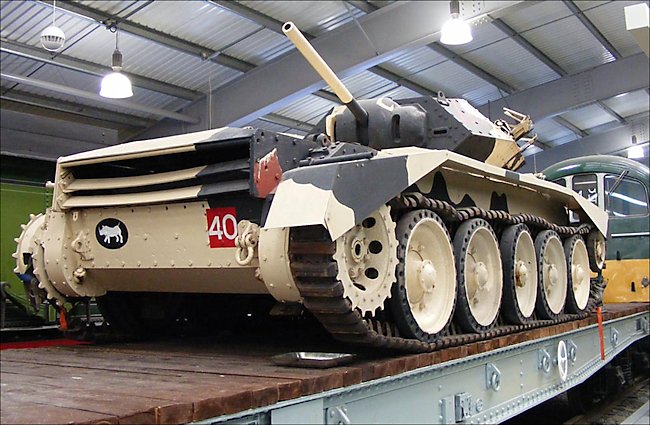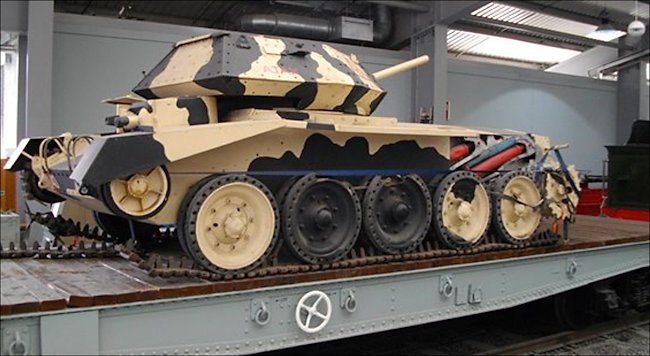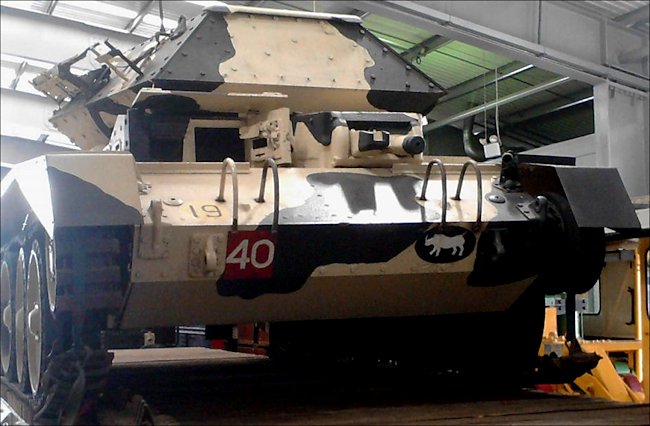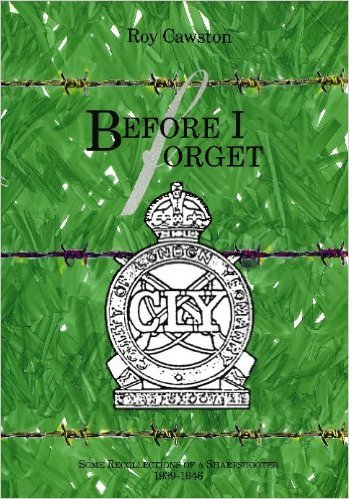A15 Crusader Mark I tank
This British A15 Cruiser tank can be seen at the National Railway Museum's Locomotion Annexe Shildon, County Durham, England. It is one of the two restored MkI examples to survive.

Surviving A15 British Crusader MkI tank at the National Railway Museum's Locomotion Annexe Shildon, County Durham, England
Location
The Museum is a three minute walk from Shildon Railway Station. The entrance to the car park is down a road at the junction of Dale Road and Spout Lane in Shildon DL4 2RE, England. The road leads you into a small industrial estate that is next to the museum. The car park is the last turning on the left. The website is www.nrm.org.uk and click on the NRM Shildon link.
Specifications
The Crusader tank was give a number of designations: Tank, Cruiser, MK VI or A15 Crusader MkI. It was armed with a 2 pounder quick firing (2pdr QF) 40mm main gun that only fired AP Armour piercing rounds. The Crusader Mk III was armed with a 6pdr QF (57mm) gun. A Besa machine gun was fitted in the hull and some versions had a second in the turret and a bren gun on the roof of the turret. The early Crusader tanks had a crew of four or in some cases five men. The Mark III Crusader only had a crew of three men. They were protected by armour that only had a maximum thickness on the front of 40mm. This was increased on the Mk II to 49mm and on the Mark III to 51 mm)
The tank was powered by a Nuffield Liberty 27-litre V-12 petrol engine that produced 340 hp. This gave the Crusader a maximum road speed of 26 mph (24 km/h) and off road 15 mph (24 km/h). It had an operational range of around 200 miles (322km) on roads and 146 miles (235km) cross country.

Notice the holes around the rim of the rubber wheels on this preserved A15 British Crusader MkI tank at the NRM Shildon Museum.
This Crusader's history
This Crusader Mk1 was used as a target tank on Salisbury Plain training area after the World War Two before being rescued and preserved/ It was in the same target line as the A 24 Cavalier recovered to Bovington in 1985, along with it A27(L) Centaur cousin and the Budge A27(M) Cromwell. This why the left hand side of the Crusader is not completely restored. Part of the hull is cut away to enable visitors to see the suspension.
If you look closely at the rubber wheels on this tank you will notice that they have holes around the edge. The holes were there to improve shock absorption but they were gradually eliminated as the weight of the tank types rose. This Crusader still has it's original Mk1 turret which is a good indicator that it was retained in the UK by a training depot and not used operationally. Those that were sent to the battlefield were normally upgraded.

The Driver's vision hatch is open. As it is a British tank the driver sat on the right of the vehicle. The hull machine gunner sat on his left.
The Crusader Tank Crew
Roy Cawston was a tank crew member of a A15 Crusader tank belonging No.2 troop, C Squadron, 4th County of London Yeomanry (Sharpshooters) Regiment (4CLY). He was posted to North Africa and taken prisoner when his Crusader tank was knocked out at the battle of Bir el Gubi, Libyia on the 19th November 1941. He wrote down some of his memories in a book called 'Before I Forget - Some Recollections of a Sharpshooter 1939 - 46' Here is an extract:-
'In the Crusader's power-operated turret which had a full 3600 traverse, there were the tank's Commander, Gunner and Loader/Operator. The Driver sat in the front offside section of the tank's hull or fixed body. The Commander's seat was central behind the recoil guard of the 2 Pounder gun with the wireless set immediately behind him. '
'When the turret was closed he had a periscope with all-round vision. The Gunner sat in front of and to the left of the Commander with his right eye to his gun-aiming telescope, his right shoulder tucked into the padded rest by which he elevated or depressed the guns. He traversed the turret by means of a twist grip in his left hand and fired the guns remotely with his right hand on two triggers one each for the 2 Pounder and Besa machine gun. '
'The Loader's position was to the right of the Commander and with the breeches of the guns between himself and the Gunner. He sat facing inwards so that he could feed shells into the 2 Pounder and be within touching distance of the Gunner whose right shoulder had to be tapped every time the gun was loaded and ready to fire. '
'We were only supplied with armour-piercing rounds - if we had had high explosive ammunition as well, the outcome of our imminent action could well have been very different. For his next trick, as the saying goes, the Loader who was also the Wireless Operator, had to listen out to the wireless traffic coming over his headphones and be ready to operate the set as required as well as reloading fresh ammunition belts into the Besa machine gun.'
'Although he had his own periscope his job as Loader required that his full attention was concentrated on what was going on inside the turret and he had to rely on his crew-mates to keep him posted about the situation immediately outside the tank. Ammunition was stored in ready-use lockers around the inside of the hull in such a way as to be accessible no matter what position the turret was in. The Driver could possibly exit via the turret but only when it was in one or two certain positions relative to the hull. Normal access to his seat was through the driver's hatch in the right front of the hull. '
'The factor which limited the capacity of the Crusader's fighting compartment was the diameter of the turret ring within which three members of the crew plus guns and wireless had to operate. The turret ring was slightly less than 60 inches in diameter! '
'In our 'Mark' of Crusader there was a discarded machine gun position to the left of the Driver which we used to store some of the crew's personal gear. The balance of our gear was festooned around the exterior of the hull below the turret line along with spare lengths of track and 'jerrycans' containing spare petrol, oil and water. An additional large drum of drinking water was fixed to our rear end aft of the engine compartment. Incidentally the letters P.O.W. formed an acronym drilled into all aspiring tank crews and stood for a tank's three cardinal requirements - Petrol, Oil and Water. All too soon we were to be even more familiar with its other meaning. '
'To conclude the inventory of equipment carried about the tank's person' there were: a tarpaulin, bivouac tents, towing hawser, sundry tool lockers, steel helmets and emergency food rations. Mounted on the outside of the turret were a sun-compass and a Bren gun on an anti-aircraft mounting. If I have left out anything, it is probably the kitchen sink. '
Where can I find other preserved Crusader Tanks?
- Crusader Mk I - National Railway Museum, Shildon, County Durham
- Crusader Mk I - Royal Australian Armoured Corps Tank Museum, Puckapunyal, Australia
- Crusader Mk II - IWM Duxford
- Crusader Mk II - Royal Jordanian Tank Museum, Jordan
- Crusader Mk II - National Museum of Military History, Johannesburg, South Africa
- Crusader Mk II - Light Horse Regiment, Kelvin, Johannesburg, South Africa
- Crusader Mk II - Moth Hall, Florida Dardanelles, Johannesburg, South Africa
- Crusader Mk II - Moth Hall, Brenthurst, Johannesburg, South Africa
- Crusader Mk II - Moth Hall, Roodepoort Chilly Trench, Johannesburg, South Africa
- Crusader Mk II - Dam Snake Park, Hartebeespoort, NW Province, South Africa
- Crusader Mk II - Cosy Corner Shellhole, Brakpan, Gauteng province, South Africa
- Crusader Mk II - Warrior Shellhole, Muldersdrift, Gauteng province, South Africa
- Crusader Mk II - Group 15 HQ, Thaba Tswane, Pretoria, Gauteng province, South Africa
- Crusader Mk II - Pretoria Regimental base, Salvokop, Pretoria, Gauteng province, South Africa
- Crusader Mk II - 2x School of Armour Museum, Tempe, Bloemfontein, Free State provinve, South Africa
- Crusader Mk II - Special Services Battalion Museum, Tempe Bloemfontein, Free State province, South Africa
- Crusader Mk II - Stored at Hogsville, Free State province, South Africa
- Crusader Mk II - Collings Foundation Collection, California, USA
- Crusader Mk II 17-pounder gun-tractor - National War and Resistance Museum, Overloon, Netherlands
- Crusader Mk III - Tank Museum, Bovington, Dorset, England
- Crusader Mk III wreck - El-Alamain War Museum, Egypt
- Crusader Mk III - National Armor and Cavalry Museum, Fort Benning, GA, USA
- Crusader Mk III AA (Anti-Aircraft) - Musée des Blindés, Saumur, France
- Source - Pierre-Oliver Buan - http://the.shadock.free.fr/Surviving_Panzers.html
Crusader Tank book
 Buy it now
Buy it now